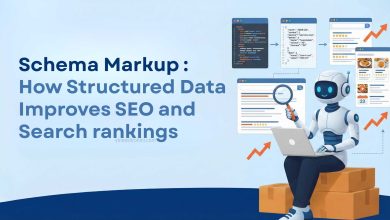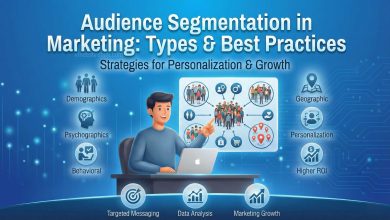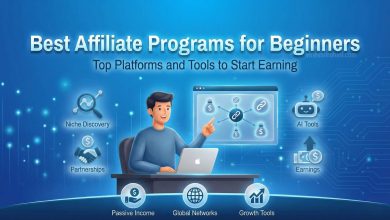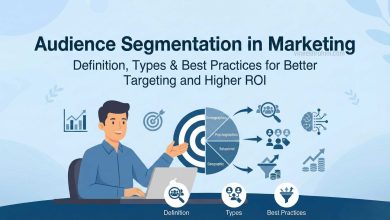Types of Digital Marketing : A Comprehensive Guide 2024
Types of Digital Marketing : Digital marketing has transformed how businesses engage with their audiences, helping them reach customers across the globe, build brand awareness, and drive revenue. Unlike traditional marketing, digital marketing operates on online platforms, using data-driven strategies and tools to connect with consumers. This guide explores the various types of digital marketing, their unique features, and how they can benefit your business.
Table of Contents
Digital marketing includes a wide variety of strategies, each targeting specific channels and platforms. From social media marketing to email campaigns, the possibilities are endless. Let’s dive into the primary types of digital marketing and understand how they can be utilized for effective promotion.
1. Search Engine Optimization (SEO)

Definition
Search Engine Optimization (SEO) involves optimizing your website to rank higher on search engine results pages (SERPs). It is a long-term strategy that focuses on increasing organic (non-paid) traffic by improving your site’s visibility to users searching for related content.
Key Components
- On-Page SEO: Optimizing individual web pages, including meta titles, descriptions, headings, and keyword usage.
- Off-Page SEO: Building backlinks from authoritative websites to increase your site’s credibility.
- Technical SEO: Enhancing website structure, speed, mobile-friendliness, and overall usability.
- Content SEO: Creating high-quality, engaging, and keyword-optimized content to attract search engine traffic.
Benefits
- Cost-effective way to drive traffic.
- Builds credibility and trust among users.
- Increases visibility, leading to more conversions.
Best Practices
- Conduct thorough keyword research.
- Update your website regularly with fresh, relevant content.
- Optimize for mobile users and improve website loading speed.
2. Pay-Per-Tap Advertising
Definition
PPC is a paid advertising model where businesses pay a fee each time their ad is taped.
Also Read : Top 10 Careers in Digital Marketing
It is an effective way to drive traffic quickly, often appearing at the top of search engine results or on social media platforms.
Popular Platforms
- G Ads: Ads appear on Google search results and partner websites.
- Social Media Ads: Fb, Insta, LinkedIn, and Twitter offer PPC advertising options.
- Display Ads: Visual ads displayed across websites within a specific network.
Benefits
- Immediate visibility and traffic.
- Targeted audience reach using demographics, interests, and location.
- Easy to measure and track ROI.
Best Practices
- Use A/B testing to determine the most effective ad creatives.
- Continuously optimize campaigns based on performance metrics.
- Set clear goals and budget for ad spend.
3. Social Media Marketing (SMM)
Definition
Social Media Marketing involves promoting your brand, products, or services through social media platforms to build brand awareness and engage with your target audience.
Popular Platforms
- Fb: Great for community engagement and paid ads.
- Insta: Focuses on visual content like photos and videos.
- Twitter: Ideal for real-time updates and customer interaction.
- LinkedIn: Best for B2B marketing and professional networking.
- TikTok: Popular for creative short-form video content targeting younger audiences.
Benefits
- Builds a loyal community of followers.
- Provides direct communication with customers.
- Cost-effective marketing, especially for small businesses.
Best Practices
- Post consistently and at the right times for maximum engagement.
- Use a mix of organic posts and paid advertisements.
- Monitor analytics to refine your strategy.
4. Content Marketing
Definition
Content Marketing involves creating and distributing valuable, relevant, and engaging content to attract and retain a clearly defined audience. This strategy aims to provide solutions to customer problems, build trust, and establish thought leadership.
Types of Content
- Blog posts
- Videos (YTube, TikTok, etc.)
- Infographics
- E-books and whitepapers
- Podcasts
- Webinars
Benefits
- Drives organic traffic through SEO-optimized content.
- Builds long-term relationships with customers.
- Positions your brand as an industry authority.
Best Practices
- Focus on high-quality, original content tailored to your audience.
- Leverage storytelling to make your content more relatable.
- Distribute content across multiple channels for maximum reach.
5. Email Marketing
Definition
Email Marketing is a direct form of digital marketing where businesses send targeted emails to their subscribers to promote products, share updates, or nurture customer relationships.
Types of Email Campaigns
- Newsletters
- Promotional offers
- Welcome emails
- Cart abandonment reminders
- Event invitations
Benefits
- High ROI compared to other digital marketing strategies.
- Personalized communication with subscribers.
- Helps nurture leads and build customer loyalty.
Best Practices
- Use segmentation to send tailored messages.
- Personalize email content for higher engagement.
- Optimize subject lines and email design for better open rates.
6. Influencer Marketing

Definition
Influencer Marketing involves partnering with social media influencers who have a large and engaged following to promote your products or services.
Types of Influencers
- Mega-Influencers: Celebrities with millions of followers.
- Macro-Influencers: Social media personalities with 100,000+ followers.
- Micro-Influencers: Niche influencers with smaller but highly engaged audiences.
- Nano-Influencers: Individuals with fewer than 10,000 followers, often highly trusted by their audience.
Benefits
- Builds trust and credibility with the influencer’s audience.
- Reaches highly targeted demographics.
- Boosts brand visibility and awareness.
Best Practices
- Choose influencers whose audience aligns with your target market.
- Ensure the partnership feels authentic and not overly promotional.
- Track campaign performance using specific metrics.
7. Affiliate Marketing
Definition
Affiliate Marketing is a performance-based marketing strategy where businesses reward affiliates (partners) for driving traffic or sales through their referral links.
How It Works
- Affiliates promote your products via blogs, websites, or social media.
- When a customer makes a purchase through an affiliate’s unique link, the affiliate earns a commission.
Benefits
- Cost-effective as you only pay for results.
- Expands your reach through affiliate networks.
- Drives traffic from trusted sources.
Best Practices
- Provide affiliates with high-quality promotional materials.
- Offer competitive commission rates to incentivize performance.
- Monitor affiliate activities to ensure compliance with brand guidelines.
8. Video Marketing
Definition
Video Marketing involves using video content to promote products, services, or brand messages. Platforms like YTube, TikTok, and Insta have made video a dominant form of digital content.
Types of Video Content
- Product demos
- Tutorials and how-to guides
- Behind-the-scenes footage
- Customer testimonials
- Live streams
Benefits
- Engages audiences effectively, as videos are more captivating than text.
- Improves conversion rates, especially on landing pages.
- Increases social sharing and virality.
Best Practices
- Keep videos concise and visually appealing.
- Add subtitles for accessibility.
- Optimize videos for SEO with keywords and tags.
9. Mobile Marketing
Definition
Mobile Marketing targets users on their smartphones or tablets through channels like SMS, mobile apps, or mobile-optimized websites.
Key Channels
- SMS and push notifications
- In-app advertising
- Mobile-friendly websites and email campaigns
- QR codes for promotions
Benefits
- Provides instant communication with users.
- Leverages location-based targeting for personalized offers.
- Enhances the customer experience with mobile-friendly designs.
Best Practices
- Ensure your website is responsive and mobile-optimized.
- Use concise messaging for SMS and push notifications.
- Respect user privacy and obtain proper permissions.
10. Search Engine Marketing (SEM)
Definition
Search Engine Marketing (SEM) involves using paid search ads to promote your business on search engines like Google and Bing. Unlike SEO, SEM focuses on paid strategies to drive traffic.
Popular SEM Features
- G Ads campaigns
- Pay-per-Tap advertising
- Retargeting ads
Benefits
- Provides immediate visibility on search engines.
- Targets users actively searching for your products.
- Highly measurable and adjustable.
Best Practices
- Use highly targeted keywords.
- Optimize ad copy and landing pages for conversions.
- Monitor campaigns regularly to improve performance.
11. Display Advertising
Definition
Display Advertising uses visual ads, including banners, images, and videos, to promote your brand on websites, apps, and social media platforms.
Types of Display Ads
- Banner ads
- Pop-ups
- Retargeting ads
- Rich media ads (interactive elements)
Benefits
- Increases brand visibility across the web.
- Supports retargeting campaigns to re-engage past visitors.
- Allows for creative and engaging ad formats.
Best Practices
- Use eye-catching visuals and concise messaging.
- Avoid intrusive formats that may annoy users.
- Test different designs and placements for optimal performance.
12. Online Public Relations (PR)
Definition
Online PR involves building your brand’s reputation through digital media channels like blogs, news websites, and social media. It includes managing relationships with online journalists and influencers to generate positive press coverage.
Key Tactics
- Press releases and news articles.
- Collaborations with bloggers and online publications.
- Responding to online reviews and comments.
Benefits
- Enhances credibility and trust in your brand.
- Provides valuable backlinks for SEO.
- Improves brand perception among target audiences.
Best Practices
- Create engaging press releases and pitches.
- Respond to negative reviews professionally and constructively.
- Build long-term relationships with media professionals.
13. Conversational Marketing

Definition
Conversational Marketing involves real-time, one-on-one interactions with customers through chatbots, live chat, or social messaging apps.
Key Tools
- AI-powered chatbots (e.g., on websites or social media).
- Messaging apps like Fb Messenger, and Telegram.
- Live chat software for customer support.
Benefits
- Offers personalized experiences for users.
- Reduces response time and improves customer satisfaction.
- Collects valuable customer data for future marketing efforts.
Best Practices
- Use AI chatbots for 24/7 support.
- Train customer service representatives for complex queries.
- Maintain a friendly and professional tone in interactions.
14. Podcast Marketing
Definition
Podcast Marketing leverages audio content to engage listeners, share insights, and promote products or services. Podcasts have grown in popularity due to their convenience and engaging format.
How to Use
- Launch your own branded podcast.
- Sponsor popular podcasts in your niche.
- Appear as a guest on established podcasts.
Benefits
- Reaches a highly engaged and loyal audience.
- Builds thought leadership in your industry.
- Offers opportunities for storytelling and brand positioning.
Best Practices
- Focus on providing value to listeners, not just promotion.
- Use professional audio equipment for quality production.
- Promote podcasts across your marketing channels.
15. Analytics and Data-Driven Marketing

Definition
This type of marketing involves leveraging data and analytics tools to track, measure, and optimize your campaigns for better results. Platforms like Google Analytics and HubSpot provide detailed insights into customer behavior.
Key Metrics
- Website traffic
- Conversion rates
- Bounce rates
- Customer acquisition cost (CAC)
- Return on investment (ROI)
Benefits
- Helps make informed decisions based on data.
- Improves campaign performance through continuous optimization.
- Provides a clear picture of audience preferences and behavior.
Best Practices
- Regularly review analytics reports.
- Use insights to personalize marketing strategies.
- Integrate analytics tools with your CRM for a holistic view.
Types of Digital Marketing – Conclusion
Digital marketing offers endless opportunities for businesses to connect with their audience and drive growth. Each type of digital marketing serves a specific purpose, and the key to success lies in integrating multiple strategies to create a comprehensive marketing plan.
Buy Now : 498 Digital Product Ideas eBook
Understanding your target audience and choosing the right mix of strategies is critical. Whether you invest in SEO for long-term visibility, leverage PPC for instant results, or build relationships through social media, digital marketing empowers businesses to thrive in an increasingly online world.
Keywords : Types of Digital Marketing – Types of Digital Marketing 2024 – Types of Digital Marketing 2025



